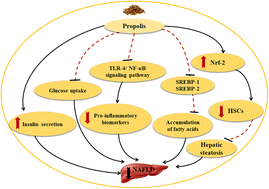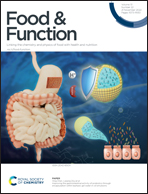Propolis supplementation in obese patients with non-alcoholic fatty liver disease: effects on glucose homeostasis, lipid profile, liver function, anthropometric indices and meta-inflammation
Abstract
This study assessed the effects of propolis supplementation on glucose homeostasis, lipid profile, liver function, anthropometric indices and meta-inflammation in patients with non-alcoholic fatty liver disease (NAFLD). In this double-blind placebo-controlled randomized clinical trial, 44 patients with NAFLD confirmed by ultrasonography findings were randomly allocated into either the “propolis” (n = 23) or “placebo” (n = 21) group along with a calorie-restricted diet (−500 kcal d−1) for 8 weeks. Fasting serum levels of metabolic factors, liver enzymes, and inflammatory factors, as well as anthropometric indices, dietary intake and appetite status were assessed pre-and post-intervention. The liver fibrosis score, homeostasis model assessment of insulin resistance (HOMA-IR) and quantitative insulin sensitivity check index (QUICKI) were also calculated. The weight, body mass index (BMI), waist and hip circumferences, and waist to height ratio significantly decreased in both groups (p < 0.001), while the waist to hip ratio (p = 0.006) and serum level of total cholesterol (p = 0.038) decreased only in the propolis arm. However, no significant changes in anthropometric measurements and lipid profile were found between the groups at the end of the intervention. Fasting blood sugar (p = 0.037), the serum insulin level (p = 0.040), HOMA-IR (p = 007), desire to eat sweet foods (p = 0.005) and the NAFLD fibrosis score (p = 0.013) decreased significantly in the propolis group compared to the placebo group, post-intervention after adjusting for baseline values and potential confounders. However, QUICKI showed a significant increase (p = 0.015) in the propolis arm compared to the placebo at the study endpoint. Although there were significant reductions in the serum levels of inflammatory factors including tumor necrosis factor-α (TNF-α), toll-like receptor-4 (TLR-4) and monocyte chemoattractant protein-1 (MCP-1), as well as liver enzymes and severity of fatty liver, between-group differences were not statistically significant after adjusting for the potential confounding factors. The estimated number needed to treat (NNT) due to 8-week propolis supplementation (510 mg per day) for at least 1-point improvement in NAFLD severity was found to be approximately 3. In conclusion, propolis supplementation along with a calorie-restricted diet for 8 weeks could significantly improve the glucose homeostasis, hepatic fibrosis score and liver function in patients with NAFLD. Further clinical trials are encouraged to study the effects of propolis supplementation in patients with long-term NAFLD.



 Please wait while we load your content...
Please wait while we load your content...